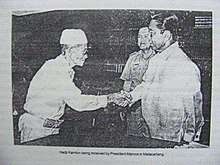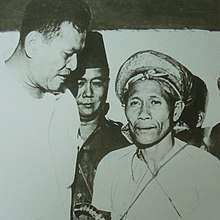Hadji Kamlon
Datu Hadji Kamlon, also known as Maas Kamlon, was a Tausug who fought during the Second World War, and afterwards, staged his own uprising against the Philippine government under Presidents Elpidio Quirino and Ramon Magsaysay. He is regarded as a folk hero among the Tausugs.[1]
Hadji Kamlon | |
|---|---|
 President Ferdinand Marcos shakes hands with Kamlon after the latter's release. | |
| Born | |
| Other names | Maas Kamlon |
| Organization | Sultanate of Sulu and North Borneo |
Uprising
In 1948, starting with a core group of 25 members, Kamlon launched an uprising to clear the issue of land reform, overthrow the Philippine government, and assert the sovereignty of the Sultanate of Sulu and North Borneo over the Tausugs.[2] Eventually, with his anti-Filipino campaign gaining traction, Kamlon's following grew to around 100 members. Armed mainly with M1918 Browning Automatic Rifles and a variety of Japanese rifles from the war, the group became known for wiping out the 7th Infantry Battalion, the Korean War veteran unit called Nenita. The gravity of Kamlon's threat shook the newly independent republic as it simultaneously dealt with other internal threats such as the communist movement Hukbalahap.[3][4] Meanwhile, the Philippine government tried to sully Kamlon's name by branding him as a bandit, criminal, and rebel, among others, to blunt his image and reputation among the people.[1]
Temporary peace and resumption of conflict

In July 1952, more than 5,000 troops supported by tanks, aircraft, and naval units were mobilized to flush out Kamlon, this time led by then Defense Secretary Ramon Magsaysay.[5][6] On July 31 of the same year, Kamlon surrendered, not because of the ensuing offensive, but in response to Magsaysay's secret meeting with him in Sulu. By this time, Kamlon had some 300 warriors with him, and was considered the second largest threat to the Philippines next to the Hukbalahap.[7]
However, observers were quick to judge Kamlon's actions as a farce, likely to serve as relief from the fighting. President Elpidio Quirino himself dispelled any claims that he shook hands with Kamlon as a result of this surrender.[8] This doubt would be justified when in August 1952, a week after his surrender, Kamlon returned to continue his rebellion, and the Filipino troops were back in Sulu to fight against his forces. The resulting battle caused 20 casualties on Kamlon's side.[9]
A few months later, in November, Kamlon once again surrendered. With 23 of his men, they were convicted and sentenced to life imprisonment.[10] It would not take long before Kamlon was out again to resume his rebellion. This cycle would go on until September 24, 1955, when Kamlon delivered his unconditional surrender after a battle with the 2nd Infantry Division, Sulu Air Task Group (SATAG, composed of 6th and 7th Fighter Squadrons), and a gunboat of the Philippine Navy that cost him 190 of his fighters.[11] The entire seven-year campaign cost the government ₱185 million (US$985 million in 2019 figures).[1]
Imprisonment
Kamlon's initial conviction was upheld and he was sentenced to life imprisonment, a condition Kamlon himself contested, claiming that his surrender was not entirely unconditional because there was "a promise of a parole". However, the Philippine government countered with the justification that Kamlon was not promised anything beyond his partial pardon. Since he had violated the conditions of his pardon, he was disqualified. The conditions included a monthly report from Kamlon to the Philippine Constabulary, his assistance to the surrender of rebels and firearms in the Sulu area, and his permission to be regularly visited by an authority from the Philippine government.[12] Among those who worked for his release was Nur Misuari, later chairman of the Moro National Liberation Front. For those who survived the uprising, and those who would follow the path of Moro rebellion, the aging Kamlon was viewed as a pioneer in fighting for independence and liberty. He was finally granted a pardon by President Ferdinand Marcos.[13]
Popular culture
Kamlon was portrayed by Ramon Revilla in the 1981 film Kamlon. The film was an entry in the 1981 Metro Manila Film Festival.[14]
See also
References
- Mawallil, Amir. "What makes a hero?". ABS-CBN News. Retrieved 23 September 2019.
- Omar, Ibrahim (2018). Diary of a Colonized Native. Singapore: Partridge Publishing. Retrieved 23 September 2019.
- Taylor, Victor. "The Beginnings Of The Abu Sayyaf Group". Mackenzie Institute. Retrieved 23 September 2019.
- Mercene, Floro. "Maute's all the way back to Kamlon". Manila Bulletin. Retrieved 23 September 2019.
- "TANKS HUNT FOR FILIPINO; Kamlon, Notorious Bandit, Is Target of All-out Campaign". The New York Times. Retrieved 23 September 2019.
- "How do you solve a problem like the Moro?". Philippine Star. Retrieved 23 September 2019.
- "THE PHILIPPINES: Peace under the Palms". Time. Retrieved 23 September 2019.
- "MORO SURRENDER VIEWED AS FARCE; Observers Believe Bandit Chief Outwitted Philippine Officials and That Drive Will Fail". The New York Times. Retrieved 23 September 2019.
- "FILIPINOS TRAP OUTLAWS; Troops Catch Up With Unit of Datu Kamlon Bandits". The New York Times. Retrieved 23 September 2019.
- "Official Month in Review: November 1952". Official Gazette. Retrieved 23 September 2019.
- "Historical Atlas of the Republic of the Philippines" (PDF). Retrieved 23 September 2019.
- "G.R. No. L-12686". Chan Robles Virtual Law Library. Retrieved 23 September 2019.
- Stern, Tom (2017). Nur Misuari: An Authorized Biography. Anvil. Retrieved 23 September 2019.
- "Kamlon (1981)". IMBb. Retrieved 24 September 2019.